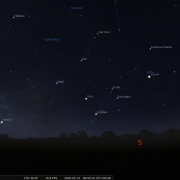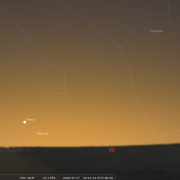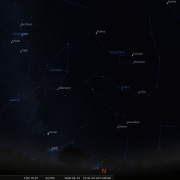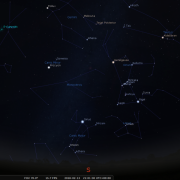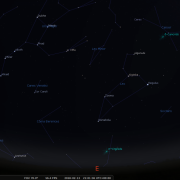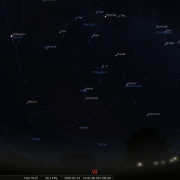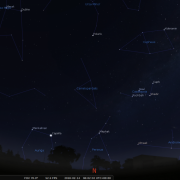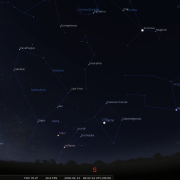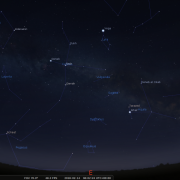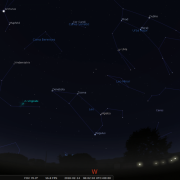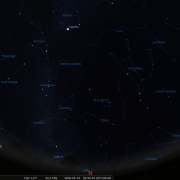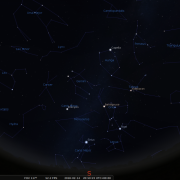In this month's Sky Notes:
Planetary Skylights
For much of February the dawn sky still hosts the majority of the naked eye planets, with Jupiter, Mars and Saturn all visible.

 Jupiter is the most conspicuous, a bright beacon (mag -2.1) due south around 06:00h. If you can get chance to observe, dawn is usually a better time to do so, simply because atmospheric interference is normally less than during the evening. Planetary detail is therefore easier to resolve and Jupiter is a particularly fine target for any size aperture. The disk always offers up plenty of interest (belts, banding, great red spot etc ) and the dance of the Galilean moon is fascinating to follow. The waning Moon passes nearby on the 8th.
Jupiter is the most conspicuous, a bright beacon (mag -2.1) due south around 06:00h. If you can get chance to observe, dawn is usually a better time to do so, simply because atmospheric interference is normally less than during the evening. Planetary detail is therefore easier to resolve and Jupiter is a particularly fine target for any size aperture. The disk always offers up plenty of interest (belts, banding, great red spot etc ) and the dance of the Galilean moon is fascinating to follow. The waning Moon passes nearby on the 8th.
 Trailing the ‘king of planets’ by some 10 degrees or so, look for the ochre hue of Mars (mag +1), which is of similar brightness and hue to nearby Antares; chief star in Scorpius, so the two should should not be mistaken. Antares is located between Mars and the horizon. Mars passes above Antares on the 10/11th.
Trailing the ‘king of planets’ by some 10 degrees or so, look for the ochre hue of Mars (mag +1), which is of similar brightness and hue to nearby Antares; chief star in Scorpius, so the two should should not be mistaken. Antares is located between Mars and the horizon. Mars passes above Antares on the 10/11th.
Telescopically Mars is still pretty small and featureless, but as we head towards the summer, and opposition its prominence will grow. The Moon lies nearby Mars and Antares on the 9th

 Further back in the SE and lower still, look for the pearly hue of Saturn (mag +0.5) above the SSE horizon. Telescopically, Saturn is a real tonic to the eye, and with the rings wide open, now is a good opportunity to try and spot any subtle detail on the disk. The moon lies nearby on the 11th.
Further back in the SE and lower still, look for the pearly hue of Saturn (mag +0.5) above the SSE horizon. Telescopically, Saturn is a real tonic to the eye, and with the rings wide open, now is a good opportunity to try and spot any subtle detail on the disk. The moon lies nearby on the 11th.
Then, between the 10th and 14th, look for Saturn emerging into the dawn sky, sliding up and right of Mercury. The two are closest on the 13th with Saturn just above Mercury. Good hunting.
 For the first half of February, there is little planetary interest in the evening sky, Neptune (which requires a scope anyway) is lost in twilight by midmonth, which just leaves Uranus (mag 5.7) residing low in the SW toward the bottom of the ‘V’ asterism in Pisces, not far above the star Torcularis Septentrionalis.
For the first half of February, there is little planetary interest in the evening sky, Neptune (which requires a scope anyway) is lost in twilight by midmonth, which just leaves Uranus (mag 5.7) residing low in the SW toward the bottom of the ‘V’ asterism in Pisces, not far above the star Torcularis Septentrionalis.
 After midmonth matters start to improve however, when first Venus and then Mercury pop into the evening twilight sky. Keep watch low to the WSW, where Venus will start to make its presence noticed. On the 16th a very slim waxing moon, just over 20 hrs old resides upper left of Venus, which is then only a few degrees above the horizon. Wait 25 minutes AFTER sunset and see if you can spot them.
After midmonth matters start to improve however, when first Venus and then Mercury pop into the evening twilight sky. Keep watch low to the WSW, where Venus will start to make its presence noticed. On the 16th a very slim waxing moon, just over 20 hrs old resides upper left of Venus, which is then only a few degrees above the horizon. Wait 25 minutes AFTER sunset and see if you can spot them.
By the last few days of February keep an even keener eye out for elusive Mercury which climbs up into the sky lower right of Venus, overtaking it and gaining altitude as we head into March. You will require a flat unobstructed view of the SW starting to observe approximately 30 minutes after sunset. More on Mercury next month.
Meteors

There is just one minor meteor shower this month, the Alpha Aurigids. The peak (if you can call it that) falls between Feb 6-9th. The Zenith Hourly Rate only reaches sporadic levels, barely half a dozen per hour, but if you do spot a meteor heading away from the direction of the zenith, (overhead) where the constellation of Auriga resides at this time of year, it is likely to be an Aurigid!
February 2018 Sky Charts
|
Looking North
Mid-February - 21:00h |
Looking South |
|
Looking East
Mid-February - 21:00h |
Looking West
Mid-February - 21:00h |
| Looking North (morning) Mid-February - 21:00h |
Looking South (morning) Mid-February - 21:00h |
| Looking East (morning) Mid-February - 06:00h |
Looking West (morning) Mid-February - 06:00h |
| Northern Aspect Mid-February - 06:00h |
Southern Aspect Mid-February - 06:00h |
Additional Image Credits:
- Planets and Comets where not otherwise mentioned: NASA
- Sky Charts: Stellarium Software
- Log in to post comments

